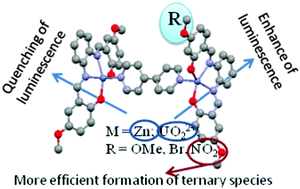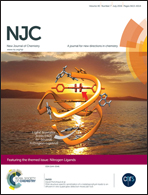Ternary assemblies comprising metal–salophen complexes and 4,4′-bipyridine†
Abstract
Two series of ternary assemblies comprising metal–salophen [salophen = N,N′-phenylenebis(salicylideneimine)] complexes (M = Zn2+ or UO22+) and 4,4′-bipyridine have been synthesized. Their absorption and emission data have been compared with those of the corresponding mononuclear derivatives. The dinuclear zinc species present lower emission intensities than those corresponding to the mononuclear precursors, while the emission of the analogous uranyl complexes is observed to increase. Absorption and emission titrations indicate that the ternary species are obtained in two independent coordination steps. The important role of the electron donating/withdrawing properties of the substituents is analyzed regarding their photophysical properties and the association constants. A MLCT transition (recorded by emission spectra) is expected and supported by the increase in the emissive properties of the complexes containing the higher electron donating substituent (methoxy). Nevertheless, this electron donating character disfavors the coordination to bipyridine as shown by the lower calculated association constants. DFT calculations have been performed on the zinc derivatives in order to estimate the relative stability of the dinuclear complexes.

- This article is part of the themed collection: Nitrogen Ligands

 Please wait while we load your content...
Please wait while we load your content...